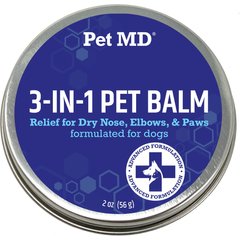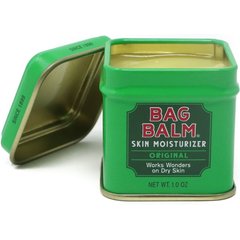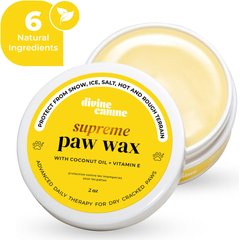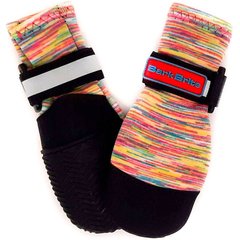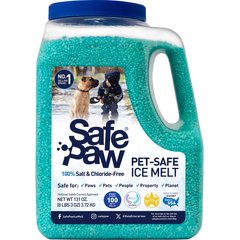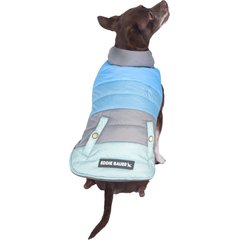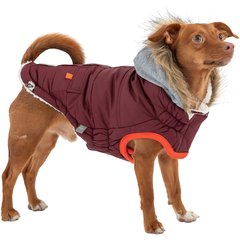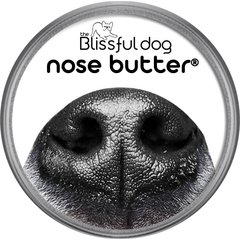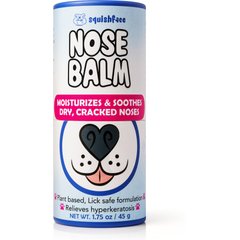How To Protect Dog Paws in Winter

Photo by Chewy
Winter is in full swing in many parts of the country, and our dogs are feeling the chill.
So how do you keep their paws, coat, and nose healthy during winter walks when it’s freezing outside or during the windiest blizzards?
From the tips of their cute wet noses to the bottom of their paws, here’s how to care for your pup in the coldest months.
Key Takeaways
- Dog paws require extra care in winter, so keep them protected with balms, booties, and daily checks.
- All dogs will need a coat if the temperature drops below 20 F, but many dogs can use one even when the temp is as high as 40 F.
- Moisturizing shampoos and conditioners can help prevent winter dryness.
- Don’t forget the nose: Use dog-safe balms to soothe dry, cracked winter noses.
How To Protect Dog Paws in Winter
Use Balm for Cracked Paws
During winter, the dry environment can cause your dog’s paw pads to crack.
Try a moisturizer, like the Pet MD Paw Balm 3-in-1 or the Bag Balm Pet Nose, Paw & Hot Spot Moisturizer.
Recommended Products
You can also use a wax, like Musher’s Secret Paw Protection Natural Dog Wax or Divine Canine Supreme Paw Wax with Coconut Oil & Vitamin E Dog Paw Cream.
Recommended Products
Get Some Dog Booties
Ice and snow can accumulate on paw pads, which isn’t very comfortable for your pup.
Plus, most ice melt products contain salt, which can cause GI distress in dogs when they lick it off their feet or eat snow that has ice melt in it.
Additionally, the salts and cold temperatures can lead to skin irritation as well as drying and cracking of the skin on their paw pads.
So try a cute pair of dog booties, like Bark Brite All Weather Reflective Neoprene Dog Boots or Muttluks Original Fleece-Lined Winter Dog Boots, to keep them warm and avoid the elements and ice melts.
Recommended Products
If your dog isn’t into them at first, don’t worry: Most dogs take some time to get used to them.
While you’re at it, consider using a pet-safe ice melt, like Safe Paw PetSafe Ice Melt. These pet-safe de-icing products are free of salts and chlorides and typically contain ingredients such as urea or magnesium chloride, which are safer for pets.
Recommended Product
The ingredients in pet-safe ice melts are gentler on paw pads and stomachs, but still should not be eaten.
Vomit, diarrhea, and dehydration are common symptoms of ice melt ingestion, and seizures are also possible.
If you suspect your dog has ingested ice melt, call Pet Poison Helpline at 855-764-7661 (a fee may apply) or take them immediately to an emergency vet.
Perform Daily Paw Checks
You may not notice there’s a problem until you see your dog licking or chewing their paws—and by that time, they’ll require a vet visit.
Daily paw checks can help keep paws healthy.
Look between the toes, under the pads, and around the base of the toenails for any signs of cracked or scaling skin, sores, or pigment changes. Cracked skin can lead to secondary bacterial infections in the feet.
If you see any cracks or wounds, or your dog is limping or won’t stop licking their feet, call your veterinarian.
How to Protect Your Dog’s Fur in Winter
Get Them a Cold-Weather Jacket
If it’s lower than 20 F outside, your dog should wear a winter coat for dogs, like the Eddie Bauer Flora Colorblock Puffer Dog Parka or the GF Pet Winter Sailor Dog Parka.
Recommended Products
Smaller or thin-coated dogs may need a jacket in temperatures as high as 40 F.
Take Care of Dry, Wintery Skin
A moisturizing dog shampoo and conditioner, like the Veterinary Formula Smart Coat Complex Ultra Oatmeal Moisturizing Shampoo for Dogs and Conditioner for Dogs, can combat dry skin that winter weather brings.
Recommended Products
How to Protect Your Dog’s Nose in Winter
Your pup’s nose also needs a little bit of attention during the chilly season.
Some dogs’ noses turn paler in color during the winter. This is called a “weathered nose,” and it also might be cracked and crusty.
A dry, winter nose can be kept clean and healthy by applying a dog-specific nose balm, like The Blissful Dog Every Dog Nose Butter or Squishface Dog Nose Balm.
Recommended Products
With a little preparation, winter can be just as fun as the balmier seasons for your dog. Stay indoors just because of a little snow? Absolutely not.
FAQs About How To Protect Dog Paws in Winter
How cold is too cold for dog paws?
Every dog is different, but most dogs will start to be at risk of health problems, like frostbite, at 32 F. Even the most cold-tolerant dogs need protection when it drops to 20 F. And many pups’ paws can be cold even at higher temperatures. Just like with humans, coldness varies by individual.
Do dogs really need booties in the snow?
Some cold-tolerant breeds may be fine for short walks in the snow, but most dogs will need booties for wintry walks, and all dogs will need booties if outside for any length of time in snowy conditions.
Can I reuse dog booties in the summer?
Yes, dog booties can also be used in the summer when the pavement is often too hot for dogs’ paws.
